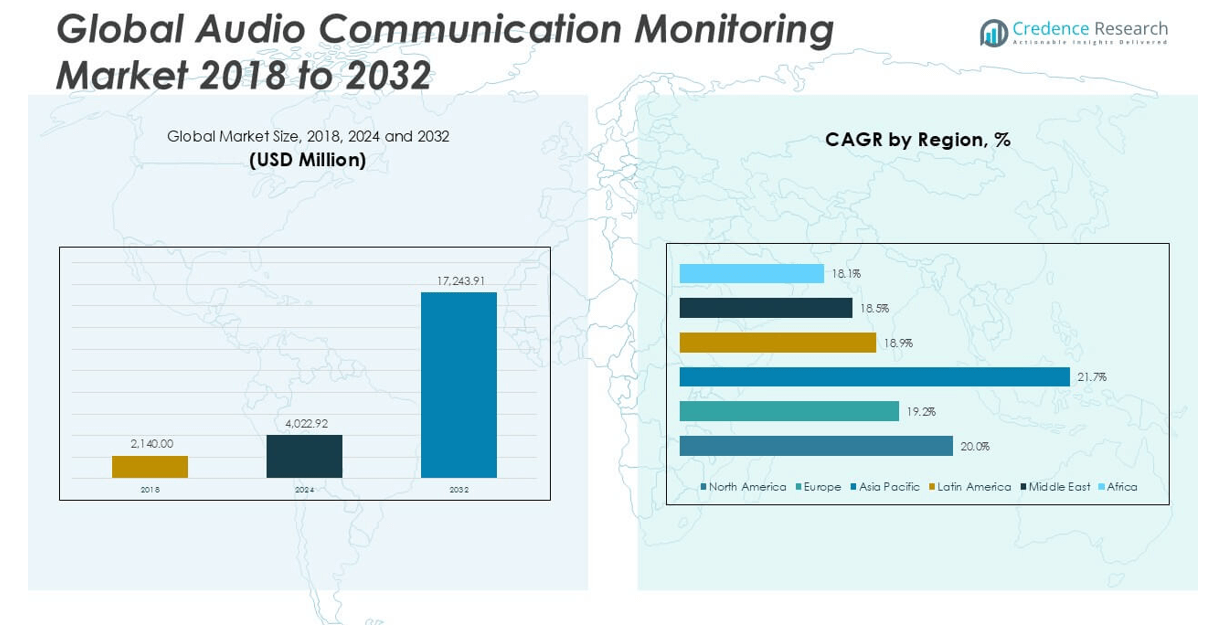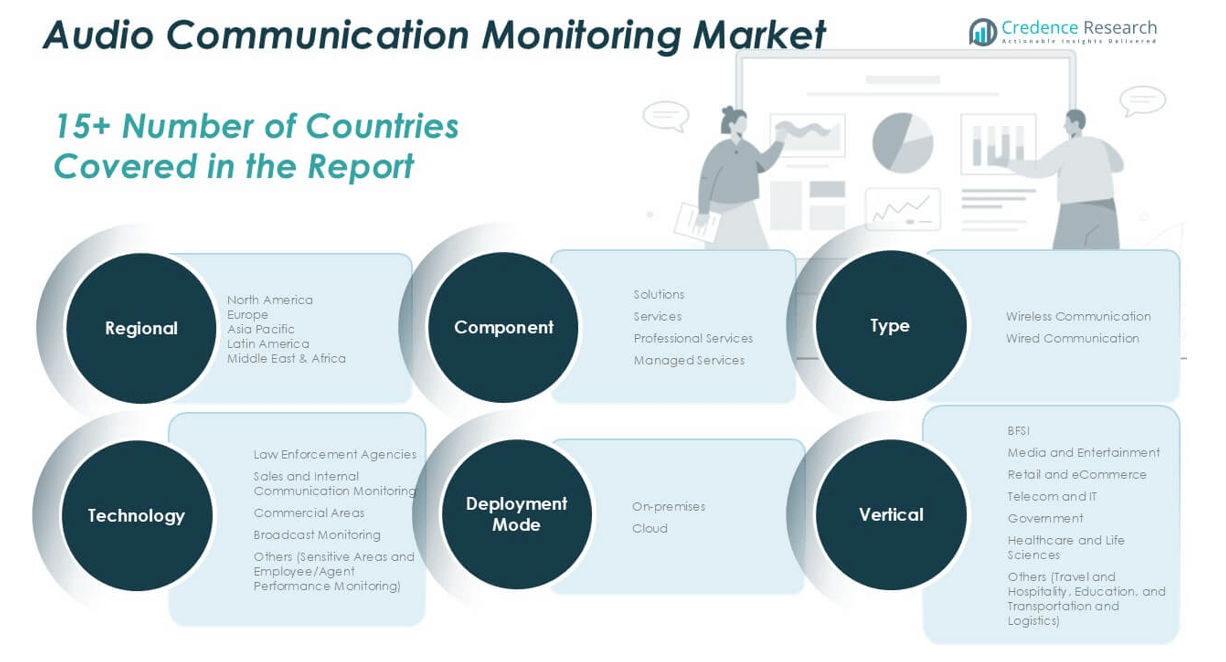CHAPTER NO. 1 : GENESIS OF THE MARKET
1.1 Market Prelude – Introduction & Scope
1.2 The Big Picture – Objectives & Vision
1.3 Strategic Edge – Unique Value Proposition
1.4 Stakeholder Compass – Key Beneficiaries
CHAPTER NO. 2 : EXECUTIVE LENS
2.1 Pulse of the Industry – Market Snapshot
2.2 Growth Arc – Revenue Projections (USD Million)
2.3. Premium Insights – Based on Primary Interviews
CHAPTER NO. 3 : AUDIO COMMUNICATION MONITORING MARKET FORCES & INDUSTRY PULSE
3.1 Foundations of Change – Market Overview
3.2 Catalysts of Expansion – Key Market Drivers
3.2.1 Momentum Boosters – Growth Triggers
3.2.2 Innovation Fuel – Disruptive Technologies
3.3 Headwinds & Crosswinds – Market Restraints
3.3.1 Regulatory Tides – Compliance Challenges
3.3.2 Economic Frictions – Inflationary Pressures
3.4 Untapped Horizons – Growth Potential & Opportunities
3.5 Strategic Navigation – Industry Frameworks
3.5.1 Market Equilibrium – Porter’s Five Forces
3.5.2 Ecosystem Dynamics – Value Chain Analysis
3.5.3 Macro Forces – PESTEL Breakdown
3.6 Price Trend Analysis
3.6.1 Regional Price Trend
3.6.2 Price Trend by product
CHAPTER NO. 4 : KEY INVESTMENT EPICENTER
4.1 Regional Goldmines – High-Growth Geographies
4.2 Product Frontiers – Lucrative Product Categories
4.3 Component Sweet Spots – Emerging Demand Segments
CHAPTER NO. 5: REVENUE TRAJECTORY & WEALTH MAPPING
5.1 Momentum Metrics – Forecast & Growth Curves
5.2 Regional Revenue Footprint – Market Share Insights
5.3 Segmental Wealth Flow – Type & Component Revenue
CHAPTER NO. 6 : TRADE & COMMERCE ANALYSIS
6.1. Import Analysis by Region
6.1.1. Global Audio Communication Monitoring Market Import Revenue By Region
6.2. Export Analysis by Region
6.2.1. Global Audio Communication Monitoring Market Export Revenue By Region
CHAPTER NO. 7 : COMPETITION ANALYSIS
7.1. Company Market Share Analysis
7.1.1. Global Audio Communication Monitoring Market: Company Market Share
7.2. Global Audio Communication Monitoring Market Company Revenue Market Share
7.3. Strategic Developments
7.3.1. Acquisitions & Mergers
7.3.2. New Product Launch
7.3.3. Regional Expansion
7.4. Competitive Dashboard
7.5. Company Assessment Metrics, 2024
CHAPTER NO. 8 : AUDIO COMMUNICATION MONITORING MARKET – BY TYPE SEGMENT ANALYSIS
8.1. Audio Communication Monitoring Market Overview by Type Segment
8.1.1. Audio Communication Monitoring Market Revenue Share By Type
8.2. Wireless Communication
8.3. Wired Communication
CHAPTER NO. 9 : AUDIO COMMUNICATION MONITORING MARKET – BY COMPONENT SEGMENT ANALYSIS
9.1. Audio Communication Monitoring Market Overview by Component Segment
9.1.1. Audio Communication Monitoring Market Revenue Share By Component
9.2. Solutions
9.3. Services
9.3.1 Professional Services
9.3.2 Managed Services
CHAPTER NO. 10 : AUDIO COMMUNICATION MONITORING MARKET – BY DEPLOYMENT MODE SEGMENT ANALYSIS
10.1. Audio Communication Monitoring Market Overview by Deployment Mode Segment
10.1.1. Audio Communication Monitoring Market Revenue Share By Deployment Mode
10.2. On-premises
10.3. Cloud
CHAPTER NO. 11 : AUDIO COMMUNICATION MONITORING MARKET – BY TECHNOLOGY SEGMENT ANALYSIS
11.1. Audio Communication Monitoring Market Overview by Technology Segment
11.1.1. Audio Communication Monitoring Market Revenue Share By Technology
11.2. Law Enforcement Agencies
11.3. Sales and Internal Communication Monitoring
11.4. Commercial Areas
11.5. Broadcast Monitoring
11.6. Others (Sensitive Areas and Employee/Agent Performance Monitoring)
CHAPTER NO. 12 : AUDIO COMMUNICATION MONITORING MARKET – BY VERTICAL SEGMENT ANALYSIS
12.1. Audio Communication Monitoring Market Overview by Vertical Segment
12.1.1. Audio Communication Monitoring Market Revenue Share By Vertical
12.2. BFSI
12.3. Media and Entertainment
12.4. Retail and eCommerce
12.5. Telecom and IT
12.6. Government
12.7. Healthcare and Life Sciences
12.8. Others (Travel and Hospitality, Education, and Transportation and Logistics)
CHAPTER NO. 13 : AUDIO COMMUNICATION MONITORING MARKET – REGIONAL ANALYSIS
13.1. Audio Communication Monitoring Market Overview by Region Segment
13.1.1. Global Audio Communication Monitoring Market Revenue Share By Region
13.1.2. Regions
13.1.3. Global Audio Communication Monitoring Market Revenue By Region
13.1.4. Type
13.1.5. Global Audio Communication Monitoring Market Revenue By Type
13.1.6. Component
13.1.7. Global Audio Communication Monitoring Market Revenue By Component
13.1.8. Deployment Mode
13.1.9. Global Audio Communication Monitoring Market Revenue By Deployment Mode
13.1.10. Technology
13.1.12. Global Audio Communication Monitoring Market Revenue By Technology
13.1.13. Vertical
13.1.14. Global Audio Communication Monitoring Market Revenue By Vertical
CHAPTER NO. 14 : NORTH AMERICA AUDIO COMMUNICATION MONITORING MARKET – COUNTRY ANALYSIS
14.1. North America Audio Communication Monitoring Market Overview by Country Segment
14.1.1. North America Audio Communication Monitoring Market Revenue Share By Region
14.2. North America
14.2.1. North America Audio Communication Monitoring Market Revenue By Country
14.2.2. Type
14.2.3. North America Audio Communication Monitoring Market Revenue By Type
14.2.4. Component
14.2.5. North America Audio Communication Monitoring Market Revenue By Component
14.2.6. Deployment Mode
14.2.7. North America Audio Communication Monitoring Market Revenue By Deployment Mode
14.2.8. Technology
14.2.9. North America Audio Communication Monitoring Market Revenue By Technology
14.2.10. Vertical
14.2.11. North America Audio Communication Monitoring Market Revenue By Vertical
14.3. U.S.
14.4. Canada
14.5. Mexico
CHAPTER NO. 15 : EUROPE AUDIO COMMUNICATION MONITORING MARKET – COUNTRY ANALYSIS
15.1. Europe Audio Communication Monitoring Market Overview by Country Segment
15.1.1. Europe Audio Communication Monitoring Market Revenue Share By Region
15.2. Europe
15.2.1. Europe Audio Communication Monitoring Market Revenue By Country
15.2.2. Type
15.2.3. Europe Audio Communication Monitoring Market Revenue By Type
15.2.4. Component
15.2.5. Europe Audio Communication Monitoring Market Revenue By Component
15.2.6. Deployment Mode
15.2.7. Europe Audio Communication Monitoring Market Revenue By Deployment Mode
15.2.8. Technology
15.2.9. Europe Audio Communication Monitoring Market Revenue By Technology
15.2.10. Vertical
15.2.11. Europe Audio Communication Monitoring Market Revenue By Vertical
15.3. UK
15.4. France
15.5. Germany
15.6. Italy
15.7. Spain
15.8. Russia
15.9. Rest of Europe
CHAPTER NO. 16 : ASIA PACIFIC AUDIO COMMUNICATION MONITORING MARKET – COUNTRY ANALYSIS
16.1. Asia Pacific Audio Communication Monitoring Market Overview by Country Segment
16.1.1. Asia Pacific Audio Communication Monitoring Market Revenue Share By Region
16.2. Asia Pacific
16.2.1. Asia Pacific Audio Communication Monitoring Market Revenue By Country
16.2.2. Type
16.2.3. Asia Pacific Audio Communication Monitoring Market Revenue By Type
16.2.4. Component
16.2.5. Asia Pacific Audio Communication Monitoring Market Revenue By Component
16.2.6. Deployment Mode
16.2.7. Asia Pacific Audio Communication Monitoring Market Revenue By Deployment Mode
16.2.8. Technology
16.2.9. Asia Pacific Audio Communication Monitoring Market Revenue By Technology
16.2.10. Vertical
16.2.11. Asia Pacific Audio Communication Monitoring Market Revenue By Vertical
16.3. China
16.4. Japan
16.5. South Korea
16.6. India
16.7. Australia
16.8. Southeast Asia
16.9. Rest of Asia Pacific
CHAPTER NO. 17 : LATIN AMERICA AUDIO COMMUNICATION MONITORING MARKET – COUNTRY ANALYSIS
17.1. Latin America Audio Communication Monitoring Market Overview by Country Segment
17.1.1. Latin America Audio Communication Monitoring Market Revenue Share By Region
17.2. Latin America
17.2.1. Latin America Audio Communication Monitoring Market Revenue By Country
17.2.2. Type
17.2.3. Latin America Audio Communication Monitoring Market Revenue By Type
17.2.4. Component
17.2.5. Latin America Audio Communication Monitoring Market Revenue By Component
17.2.6. Deployment Mode
17.2.7. Latin America Audio Communication Monitoring Market Revenue By Deployment Mode
17.2.8. Technology
17.2.9. Latin America Audio Communication Monitoring Market Revenue By Technology
17.2.10. Vertical
17.2.11. Latin America Audio Communication Monitoring Market Revenue By Vertical
17.3. Brazil
17.4. Argentina
17.5. Rest of Latin America
CHAPTER NO. 18 : MIDDLE EAST AUDIO COMMUNICATION MONITORING MARKET – COUNTRY ANALYSIS
18.1. Middle East Audio Communication Monitoring Market Overview by Country Segment
18.1.1. Middle East Audio Communication Monitoring Market Revenue Share By Region
18.2. Middle East
18.2.1. Middle East Audio Communication Monitoring Market Revenue By Country
18.2.2. Type
18.2.3. Middle East Audio Communication Monitoring Market Revenue By Type
18.2.4. Component
18.2.5. Middle East Audio Communication Monitoring Market Revenue By Component
18.2.6. Deployment Mode
18.2.7. Middle East Audio Communication Monitoring Market Revenue By Deployment Mode
18.2.8. Technology
18.2.9. Middle East Audio Communication Monitoring Market Revenue By Technology
18.2.10. Vertical
18.2.11. Middle East Audio Communication Monitoring Market Revenue By Vertical
18.3. GCC Countries
18.4. Israel
18.5. Turkey
18.6. Rest of Middle East
CHAPTER NO. 19 : AFRICA AUDIO COMMUNICATION MONITORING MARKET – COUNTRY ANALYSIS
19.1. Africa Audio Communication Monitoring Market Overview by Country Segment
19.1.1. Africa Audio Communication Monitoring Market Revenue Share By Region
19.2. Africa
19.2.1. Africa Audio Communication Monitoring Market Revenue By Country
19.2.2. Type
19.2.3. Africa Audio Communication Monitoring Market Revenue By Type
19.2.4. Component
19.2.5. Africa Audio Communication Monitoring Market Revenue By Component
19.2.6. Deployment Mode
19.2.7. Africa Audio Communication Monitoring Market Revenue By Deployment Mode
19.2.8. Technology
19.2.9. Africa Audio Communication Monitoring Market Revenue By Technology
19.2.10. Vertical
19.2.11. Africa Audio Communication Monitoring Market Revenue By Vertical
19.3. South Africa
19.4. Egypt
19.5. Rest of Africa
CHAPTER NO. 20 : COMPANY PROFILES
20.1. NICE (Germany)
20.1.1. Company Overview
20.1.2. Product Portfolio
20.1.3. Financial Overview
20.1.4. Recent Developments
20.1.5. Growth Strategy
20.1.6. SWOT Analysis
20.2. Cisco (US)
20.3. IBM (US)
20.4. Enghouse Interactive (US)
20.5. Google (US)
20.6. AudioCodes (Israel)
20.7. Integrated Research (Australia)
20.8. Martello Technologies (Canada)
20.9. Nuance Communication (US)
20.10. Avaya (US)
20.11. Veritone (US)
20.12. Relativity (US)
20.13. PathSolutions (US)
20.14. Empirix (US)
20.15. Genesys (US)
20.16. Nectar (US)
20.17. Behavox (US)
20.18. Vyopta (US)









